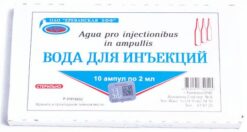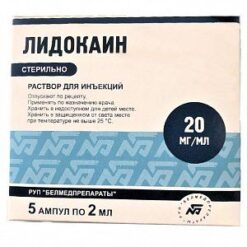No products in the cart.
Hepasol-Neo, 8 % 500 ml
€1.00
Out of stock
(E-mail when Stock is available)
Description
Hepasol-Neo is a combination drug that is a solution of amino acids.
. The composition of the preparation includes all 8 essential amino acids, which human body cannot synthesize (L-valine, L-isoleucine, L-leucine, L-lysine, L-methionine, L-threonine, L-phenylalanine, L-tryptophan), 2 conditionally essential amino acids – L-arginine, L-histidine, which are synthesized in insufficient quantities in some pathophysiological conditions, and 5 substitutable amino acids that provide an adequate metabolism in patients with liver disease. Amino acids are in L-form, which enables their direct participation in protein biosynthesis (nitrogen content is only 12.9 g/l).
L-arginine promotes the conversion of ammonia into urea and binds toxic ammonium ions formed during catabolism of proteins in the liver.
L-alanine and L-proline reduce the body’s need for glycine.
L-isoleucine, L-leucine, L-valine (essential amino acids with branched side chains) are directly absorbed by peripheral tissues (their metabolism does not depend on the degree of liver damage), reduce absorption and intake of aromatic amino acids into the CNS, reducing manifestations of hepatic encephalopathy and normalizing energy and nitrogen balance in the body.
Hepasol-Neo allows to correct amino acid disorders in liver failure and significantly improves protein tolerance in patients with cirrhosis and hepatitis and decreases severity of symptoms of hepatic encephalopathy.
It does not contain carbohydrates or electrolytes.
Pharmacokinetics
Hepasol-Neo contains various amino acids that normally enter the body continuously with food.
The amino acids administered by infusion take one of two possible metabolic pathways: the anabolic pathway, in which amino acids are bound by peptide bonds to form specific proteins, and the catabolic pathway, in which transamination of amino acids occurs. Administered as part of a complete parenteral diet along with glucose and fat (carbohydrate/fat ratio of 70:30) at a rate of 10.5 mg nitrogen/kg/h, amino acids reach a balanced concentration in the blood after 3 h.
The amino acids may be excreted unchanged with a rapid increase in blood concentrations. The t1/2 amino acids (in healthy humans) is 5-15 min (in this short time period amino acids should be used for protein synthesis). Remaining amino acids that are not used in the process of protein synthesis are subject to deamination, during which urea is formed and excreted from the body.
Arginine is almost completely reabsorbed in the renal tubules.
The metabolism of amino acids occurs in all body tissues. The degree to which they are broken down depends on the amount of stress to which the body is subjected. Stress accelerates amino acid metabolism and increases liver dysfunction, which in turn decreases amino acid metabolism. Sepsis also accelerates their metabolism, while decreased kidney function suppresses it.
In infusion of Hepasol-Neo, the absorption rate of essential amino acids is 99% and of substitutable amino acids 97%. The total and renal clearance of essential amino acids is 0.5 L/min, i.e. 1.5 ml/min, and for most essential amino acids is 0.6 L/min, i.e. 3 ml/min.
Indications
Indications
Therapy and parenteral nutrition (partial or complete – with the addition of carbohydrate solutions and fat emulsions) in liver dysfunction (hepatic failure) with or without brain dysfunction (hepatic encephalopathy); therapy of hepatic coma and precomatose states.
Active ingredient
Active ingredient
Composition
Composition
Active ingredients: L-valine 10.08 g; L-isoleucine 10.4 g; L-leucine 13.09 g; L-lysine 6.88 g; L-methionine 1.1 g; L-threonine 4.4 g; L-phenylalanine 0.88 g; L-tryptophan 0.7 g; L-alanine 4.64 g; L-arginine 10.72 g; glycine 5.82 g; L-histidine 2.8 g; L-proline 5.73 g; L-serine 2.24 g; L-cysteine 0.52 g;
Excipients: glacial acetic acid, 4.42 g; water for injection, up to 1000 ml
energy value, 1344 kJ/L (320 kcal/L); theoretical osmolarity, 770 mOsm/L; pH, 5.7-6.3
How to take, the dosage
How to take, the dosage
Intravenously, drip.
The treatment regimen is chosen depending on the concentration of ammonia in the blood and the severity of the disease.
The infusion is recommended at a rate of 1.0-1.25 ml/kg/h (30-35 drops/minute), which corresponds to 0.08-0.1 g amino acids/kg/h.
The maximum infusion rate is 1.25 ml/kg/h (0.1 g amino acids/kg/h), the maximum daily dose is 18.75 ml/kg/day (1.5 g amino acids/kg/day), i.e. 1,300 ml for a 70 kg patient.
The duration of therapy is determined individually until complete disappearance of neurological symptoms.
Interaction
Interaction
There is evidence of in vivo interaction of Hepasol-Neo components with theophylline, resulting in increased clearance of the latter.
There have been numerous in vitro drug interactions, so it is not recommended that other drugs be added to the drug solution.
Drugs that can be administered together with Hepasol-Neo: antibiotics – amikacin, ampicillin, cefotaxime, ceftriaxone, doxycycline, erythromycin, gentamicin, chloramphenicol, clindamycin, netilmicin, penicillin, piperacillin, tetracycline, vancomycin; other drugs – aminophylline, cyclophosphamide, cimetidine, cytarabine, digoxin, dopamine, famotidine, phytomenadione, fluorouracil, folic acid, furosemide, heparin, chlorpromazine, insulin, calcium gluconate, lidocaine, methyldopa, methylprednisolone, metoclopramide, methotrexate, morphine, nizatidine, norepinephrine, propranolol, ranitidine, riboflavin.
Special Instructions
Special Instructions
The use of Hepasol-Neo solution is appropriate only for the indications given.
When using this drug, periodic monitoring of electrolyte and acid balance, the degree of hydration of the body, the state of renal function is necessary.
Contraindications
Contraindications
Side effects
Side effects
Nausea, vomiting, fatigue, sweating, hyperthermia, cyanosis, decreased BP, tachycardia, allergic reactions, hyperkalemia (in chronic renal failure and in patients with severe liver disease), hypophosphatemia (in diabetes).
Overdose
Overdose
Symptoms: nausea, vomiting, sweating, fever, tachycardia, increased liver enzyme activity and residual nitrogen concentration. Increased rate of administration leads to hyperhydration and appearance of peripheral edema, development of pulmonary edema.
Treatment: symptomatic. It is recommended to stop infusion of the drug; there is no specific antidote.
Pregnancy use
Pregnancy use
Pregnant and lactating use – efficacy and safety have not been established.
Additional information
| Shelf life | 3 years |
|---|---|
| Conditions of storage | In a light-protected place at 15-25 °C |
| Manufacturer | Chemomet D.O.O., Montenegro |
| Medication form | solution for infusion |
| Brand | Chemomet D.O.O. |
Related products
Buy Hepasol-Neo, 8 % 500 ml with delivery to USA, UK, Europe and over 120 other countries.



